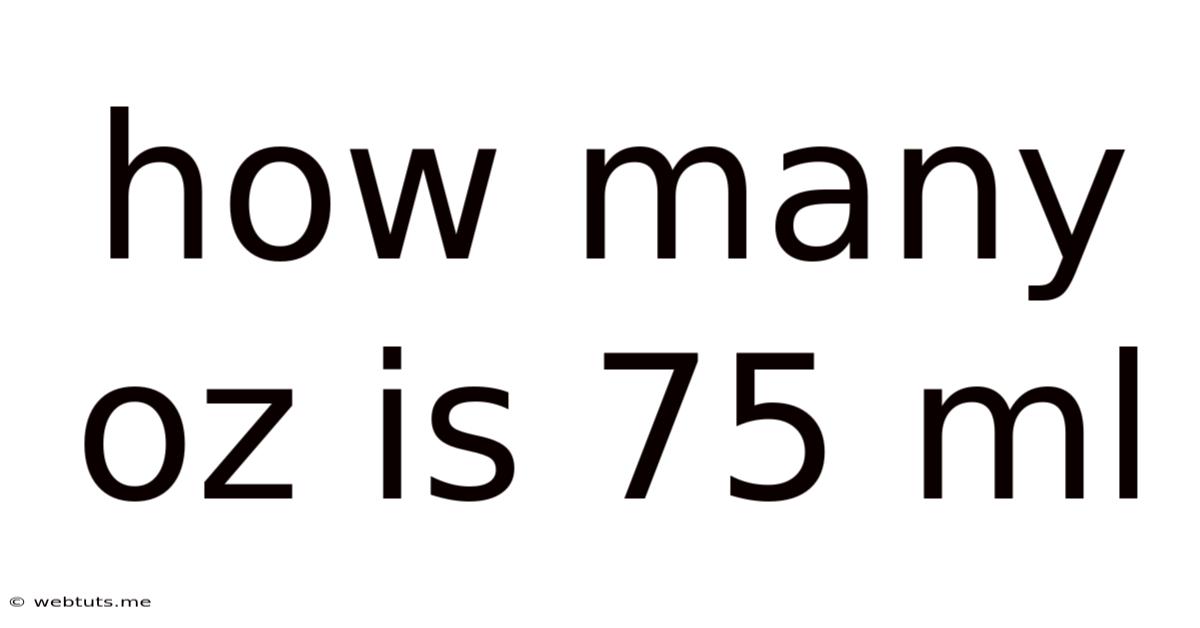How Many Oz Is 75 Ml
Webtuts
May 13, 2025 · 4 min read

Table of Contents
How Many Ounces is 75 ml? A Comprehensive Guide to Metric Conversions
Knowing how to convert between metric and imperial units is a crucial skill, especially in cooking, baking, and various scientific fields. One common conversion question revolves around milliliters (ml) and ounces (oz), specifically, how many ounces are in 75 ml? This comprehensive guide will not only answer this question but also delve into the intricacies of volume conversions, offering you a deeper understanding and equipping you with the tools to perform these conversions independently.
Understanding the Units: Milliliters and Ounces
Before we dive into the conversion, let's establish a clear understanding of the units involved:
Milliliters (ml): This is a unit of volume in the metric system. It's a thousandth of a liter (1 liter = 1000 ml). The metric system is known for its decimal-based structure, making conversions relatively straightforward.
Ounces (oz): This is a unit of volume in the imperial system, primarily used in the United States and a few other countries. There are two types of fluid ounces: the US fluid ounce and the imperial fluid ounce. These differ slightly in volume. The conversion we'll focus on uses the US fluid ounce.
The Direct Conversion: 75 ml to Ounces
The direct conversion of 75 ml to US fluid ounces is approximately 2.54 ounces. This is a widely accepted approximation. However, for precision, it's beneficial to understand the underlying calculation.
The Formula for Conversion
The precise conversion factor between milliliters and US fluid ounces is:
1 ml ≈ 0.033814 US fluid ounces
Therefore, to convert 75 ml to ounces, we multiply:
75 ml * 0.033814 oz/ml ≈ 2.536 oz
Rounding to two decimal places, we get 2.54 ounces.
Why the Slight Discrepancy?
You might encounter slightly different results depending on the conversion tool or method used. This is due to rounding differences in the conversion factor. The number 0.033814 is an approximation itself. The actual conversion factor is a longer, more precise decimal. For most practical purposes, 2.54 ounces is sufficiently accurate.
Beyond 75 ml: Mastering Volume Conversions
Understanding the conversion of 75 ml is a stepping stone to mastering volume conversions more broadly. Let's explore some related conversions and techniques:
Converting Other Milliliter Volumes to Ounces
Using the same formula (1 ml ≈ 0.033814 oz), you can easily convert any milliliter volume to ounces. Simply multiply the milliliter value by the conversion factor. For example:
- 100 ml: 100 ml * 0.033814 oz/ml ≈ 3.38 oz
- 250 ml: 250 ml * 0.033814 oz/ml ≈ 8.45 oz
- 500 ml: 500 ml * 0.033814 oz/ml ≈ 16.91 oz
- 1000 ml (1 liter): 1000 ml * 0.033814 oz/ml ≈ 33.81 oz
Converting Ounces to Milliliters
To perform the reverse conversion (ounces to milliliters), you'll use the inverse of the conversion factor:
1 oz ≈ 29.5735 ml
For example:
- 1 oz: 1 oz * 29.5735 ml/oz ≈ 29.57 ml
- 5 oz: 5 oz * 29.5735 ml/oz ≈ 147.87 ml
- 10 oz: 10 oz * 29.5735 ml/oz ≈ 295.74 ml
Practical Applications: Cooking, Baking, and More
Understanding these conversions is particularly useful in several everyday scenarios:
Cooking and Baking
Recipes often use either metric or imperial units. Knowing how to convert between them is essential for accurate measurements and consistent results. Imagine converting a recipe that calls for 75 ml of milk to ounces – you now know it's about 2.54 ounces!
Science and Medicine
In scientific experiments and medical applications, precise measurements are crucial. Converting between milliliters and ounces ensures accuracy and consistency in data collection and analysis.
Travel
When travelling internationally, familiarity with both metric and imperial units is helpful for understanding product labels, serving sizes, and general measurements.
Tips for Accurate Conversions
- Use a reliable conversion tool: Many online calculators and apps offer precise conversions. While understanding the formula is crucial, these tools can save time and reduce the risk of calculation errors.
- Pay attention to significant figures: When dealing with precise measurements, maintain an appropriate number of significant figures to avoid rounding errors that could affect the overall accuracy.
- Understand the context: Always consider the context of the conversion. In cooking, a slight variation might not be significant, but in scientific research, precision is paramount.
- Double-check your work: Especially when working with multiple conversions or complex calculations, always double-check your results to ensure accuracy.
Conclusion: Mastering the Art of Volume Conversion
Converting 75 ml to ounces, and mastering volume conversions in general, is a valuable skill that extends far beyond simple arithmetic. It's a fundamental tool applicable across various fields, enhancing accuracy, improving consistency, and facilitating better understanding in both everyday life and specialized professions. By understanding the underlying formulas, utilizing reliable conversion tools, and paying attention to detail, you can confidently navigate the world of metric and imperial units with ease. Remember, the key is understanding not just how to convert, but why these conversions are important and how they affect precision and accuracy in your work.
Latest Posts
Latest Posts
-
How Many Kilowatts In A Joule
May 13, 2025
-
How Much Is 9 Ounces In Cups
May 13, 2025
-
How Much Is 24 Tablespoons In Cups
May 13, 2025
-
How Many More Days Until September 19
May 13, 2025
-
How Many Milliliters Are In 5 Liters
May 13, 2025
Related Post
Thank you for visiting our website which covers about How Many Oz Is 75 Ml . We hope the information provided has been useful to you. Feel free to contact us if you have any questions or need further assistance. See you next time and don't miss to bookmark.